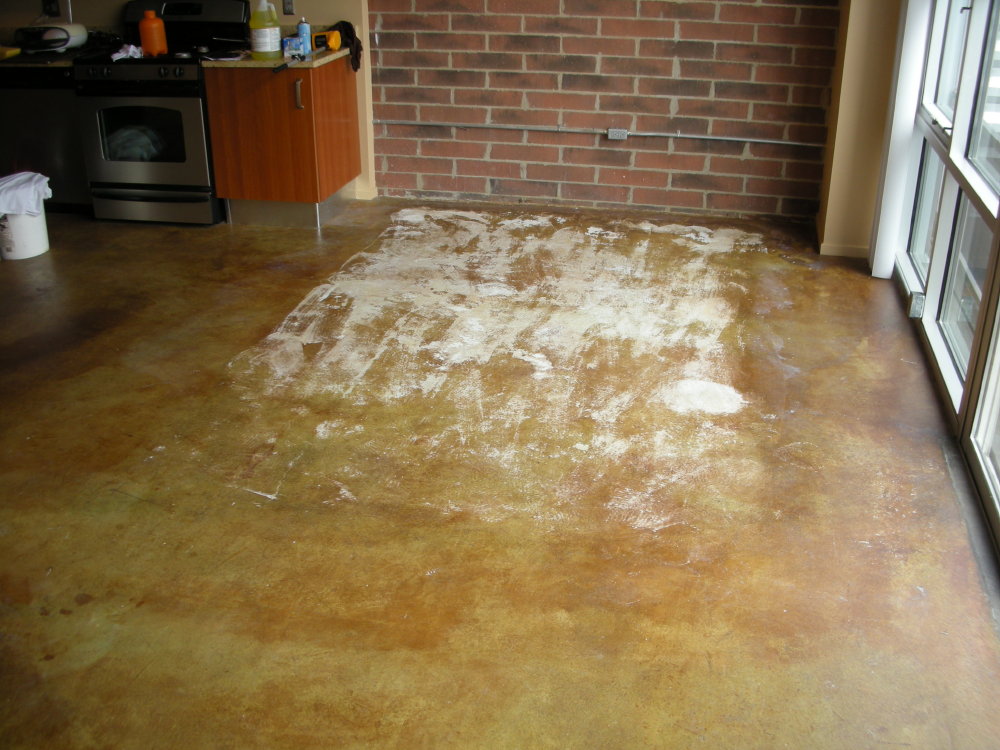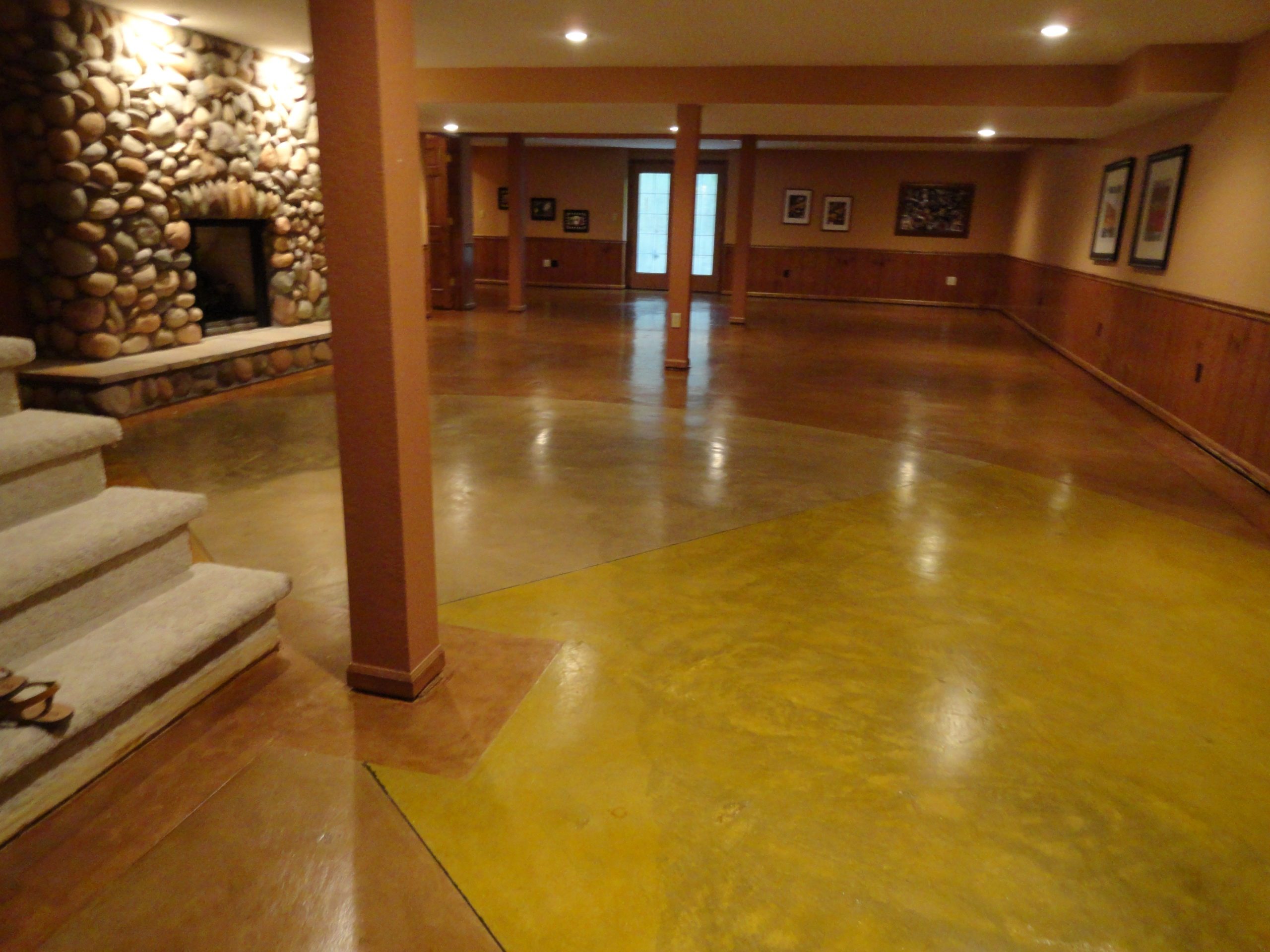Recognizing the Various Kinds of Stained Concrete for Your Next Project
Stained concrete offers numerous alternatives that accommodate various visual and practical requirements. Each kind presents distinctive attributes that influence the last look and durability of the surface area. Comprehending these distinctions is crucial for anybody preparing a project. From abundant, chain reactions of acid-based stains to the lively uniformity of strong color stains, the selections can significantly impact the end result. What aspects should one consider when choosing the excellent discolor for their certain requirements?
Introduction of Stained Concrete
Stained concrete acts as a flexible floor covering option that can improve the aesthetic allure of different spaces. This strategy includes applying a tinting agent to the surface area of existing concrete, permitting a wide spectrum of layout possibilities. Stained concrete is popular in both domestic and commercial settings, using a durable and low-maintenance service that can simulate the appearance of natural products like stone or ceramic tile.
The staining procedure can be executed utilizing water-based or solvent-based items, each offering distinctive visual impacts. The final appearance is affected by variables such as the initial concrete surface, the sort of tarnish made use of, and the application approach. Stained concrete not only improves exterior and interiors but additionally advertises sustainability by revitalizing existing concrete structures. As an outcome, it has actually obtained grip among home owners and developers seeking both performance and design in their flooring options.
Acid-Based Stains: Features and Benefits

Distinct Shade Variants
Concrete surface areas can change drastically with the application of acid-based stains, which offer an abundant combination of one-of-a-kind color variants. These stains penetrate the concrete, reacting chemically to generate dynamic earth tones that vary from deep browns and reds to soft eco-friendlies and blues. The resulting tones are typically variegated, developing a natural, marble-like appearance that enhances the concrete's personality. Each application returns distinct results as a result of variations in the concrete's make-up and the staining method made use of, making every project distinct. In addition, acid-based stains can be split or combined with various other techniques to create personalized layouts, enabling personal expression. This adaptability makes acid-based stains a popular selection for both domestic and business applications.
Chemical Responses Clarified
While several variables add to the performance of acid-based stains, the underlying chain reaction play an essential role in their distinct attributes and benefits. These stains primarily are composed of water, acid, and metal salts. When put on concrete, the acid reacts with the calcium hydroxide in the cement, producing a chemical improvement that results in irreversible color changes. The metal salts penetrate the surface and bond with the concrete, allowing for a vast array of hues and tones. This reaction not just boosts visual charm but also offers sturdiness, making the color resistant to fading and wear. Additionally, acid-based stains can develop a variegated surface that imitates all-natural rock, further improving their popularity for decorative concrete applications.
Surface Preparation Value
Accomplishing ideal outcomes with acid-based stains hinges on detailed surface preparation. This important action assurances that the concrete surface area is clean, without contaminants, and effectively profiled for perfect stain absorption. Any kind of existing sealers, dirt, or oils can prevent the chain reaction that produces the preferred color and finish, leading to unequal or patchy outcomes.
Before using the tarnish, the concrete must be mechanically cleansed or pressure washed, adhered to by a thorough assessment for cracks or imperfections that might require repair. In addition, verifying the surface area is sufficiently dried out will certainly enhance discolor adherence. By focusing on these preparatory actions, the longevity and vibrancy of acid-based stains can be substantially improved, causing a much more cosmetically pleasing and resilient coating.
Water-Based Stains: Functions and Benefits

Water-based stains permeate the concrete, offering a much more clear coating that highlights the all-natural texture and variations of the surface area underneath. They are available in a wide selection of colors, enabling innovative flexibility in style. Furthermore, dig this water-based stains are simpler to tidy up, requiring only water and soap, which simplifies the application procedure.
Their fast drying time enhances effectiveness, making them a practical choice for both DIY fanatics and specialists. In general, water-based stains provide an enticing mix of aesthetic convenience and user-friendly homes, making them a preferred option for concrete improvement tasks.
Solid Color Stains: Lively Alternatives for a Bold Look
Solid shade stains offer an efficient remedy for those seeking to produce a strong and vivid visual on concrete surfaces. These stains offer an uniform coloration that can dramatically improve the aesthetic appeal of floorings, outdoor patios, and driveways. Offered in a large range of colors, strong color stains enable for innovative expression, accommodating various design choices.
Among the vital benefits of strong shade stains is their ability to conceal flaws, offering a fresh and refined seek to aging concrete - Austin Stained Concrete Floors. In addition, their solution usually includes UV-resistant residential properties, making certain long life and shade retention even in severe climate condition
Application is simple, linked here requiring marginal prep work of the concrete surface. Once applied, strong shade stains can be secured for included security and sheen, more elevating their aesthetic top quality. With their lively choices, strong color stains are an excellent selection for those intending for an impactful and cohesive layout.
Semi-Transparent Stains: Achieving Depth and Measurement
Semi-transparent stains supply a special strategy to improving concrete surfaces by supplying depth and measurement through numerous color choices. Comprehending the application methods is essential for achieving the wanted effect, while appropriate upkeep methods assure long life. This section will certainly explore these crucial facets to make best use of the benefits of semi-transparent discoloration.
Shade Options Available
A broad selection of color choices exists for semi-transparent stains, permitting homeowners and designers to boost the natural appeal of concrete surfaces. These stains are available in an array of colors, from earthy tones like browns and terracottas to lively shades such as blues and eco-friendlies. The semi-transparent nature of these stains permits the underlying concrete to show via, producing an one-of-a-kind depth and measurement that can enhance various layout appearances. Furthermore, incorporating various colors can create personalized shades, allowing a customized try to find each job. This versatility makes semi-transparent stains a preferred choice for both exterior and interior applications, as they can balance with surrounding components while including aesthetic passion to plain concrete.
Application Techniques Described
To attain the wanted deepness and measurement with semi-transparent stains, correct application techniques are crucial. Surface preparation is vital; the concrete must be clean and totally free of any kind of pollutants. This commonly entails power washing and repairing any kind of fractures. Next off, selecting the ideal applicator, such as a sprayer, roller, or brush, can affect the last appearance. Sprayers enable for a much more even application, while rollers can help achieve structure. It is vital to use the stain in slim, also coats, allowing each layer to dry prior to including one more. Controling the application method, such as varying stress or using various tools, can create one-of-a-kind impacts. Securing the stained surface area improves the vibrancy of the shades while supplying defense.
Upkeep Finest Practices
Normal maintenance is crucial for maintaining the charm and stability of surface areas treated with semi-transparent stains. To maintain these surfaces, regular cleaning is vital. Utilizing a pH-neutral cleaner and a soft-bristle mop will aid eliminate dust and debris without harming the stain. It is a good idea to avoid extreme chemicals, as they can weaken the discolor's look. Furthermore, routine resealing every one to 3 years can protect against wear and fading. This procedure entails cleaning up the surface area thoroughly and using a suitable sealant developed for stained concrete. Property owners must likewise monitor for any type of indicators of discoloration or damage and address these problems without delay to guarantee durable vibrancy and resilience. Adhering to these best methods will certainly boost the total life-span of semi-transparent stained surface areas.
Results and Techniques: Personalizing Your Stained Concrete
Personalizing stained concrete entails an array of techniques that enhance both visual appeals and capability. Among these techniques, layering different tarnish shades can produce depth and complexity, permitting one-of-a-kind aesthetic impacts. Methods such as acid staining give a variegated appearance, while water-based stains provide a much more consistent appearance.
In addition, incorporating ornamental patterns, such as stenciling or inscription, can further personalize the surface, including elaborate designs that deal with private preferences. Texturing the concrete, whether via marking or broom surfaces, introduces tactile components that not just boost hold however also enhance aesthetic passion.
Applying sealants can enhance the color vibrancy and give defense against wear. Personalization strategies expand past simple color; they can change a basic concrete slab right into a magnificent centerpiece, making it ideal for both property and industrial spaces. Via careful option of impacts and techniques, stained concrete can accomplish a really customized look.
Maintenance and Long Life of Stained Surfaces
Although stained concrete surface areas are understood for their longevity and aesthetic appeal, keeping their integrity is crucial for ensuring long life. Normal cleaning is essential; sweeping and mopping with a pH-neutral cleaner aids avoid dust buildup and discoloration. In addition, applying a sealant every few years can secure the surface area from moisture, chemicals, and UV damages, thereby improving its life-span.
It is likewise vital to attend to any type of fractures or chips immediately. Small repairs can alleviate more degeneration, preserving the visual and architectural top quality of the surface. For outside stained concrete, seasonal upkeep, such as getting rid of snow and ice, is needed to go to this site stop surface area damages from freeze-thaw cycles.
Frequently Asked Concerns
Can I Discolor Existing Concrete Surfaces or Only New Ones?
The concern of whether existing concrete surface areas can be stained develops often. It is undoubtedly possible to stain both new and old concrete, provided the surface area is adequately ready and free of impurities for optimal adhesion.
The length of time Does the Discoloration Process Typically Take?
The discoloration process normally takes one to 3 days, relying on elements such as surface prep work, type of stain, and climate problems. Stained Concrete Floors Austin Tx. Treating time might prolong past preliminary application, influencing the total period considerably
Is Stained Concrete Safe for Outdoor Usage?
Stained concrete is usually secure for exterior use, offered it is appropriately secured. This sealing protects against dampness and UV damages, making certain longevity and safety, while also boosting the aesthetic charm of outdoor areas.
Can I Use Multiple Stain Layers for Different Effects?
Applying numerous discolor layers can achieve diverse effects on stained concrete. However, it is vital to ensure compatibility in between stains and allow correct drying time between applications to prevent unintended reactions or staining.
Are There Any Shade Limitations for Stained Concrete?
Color restrictions for stained concrete mostly depend upon the sort of discolor made use of, with water-based stains providing a wider palette contrasted to acid-based stains. Stained Concrete Austin. Attaining lively shades might require cautious choice and application methods.